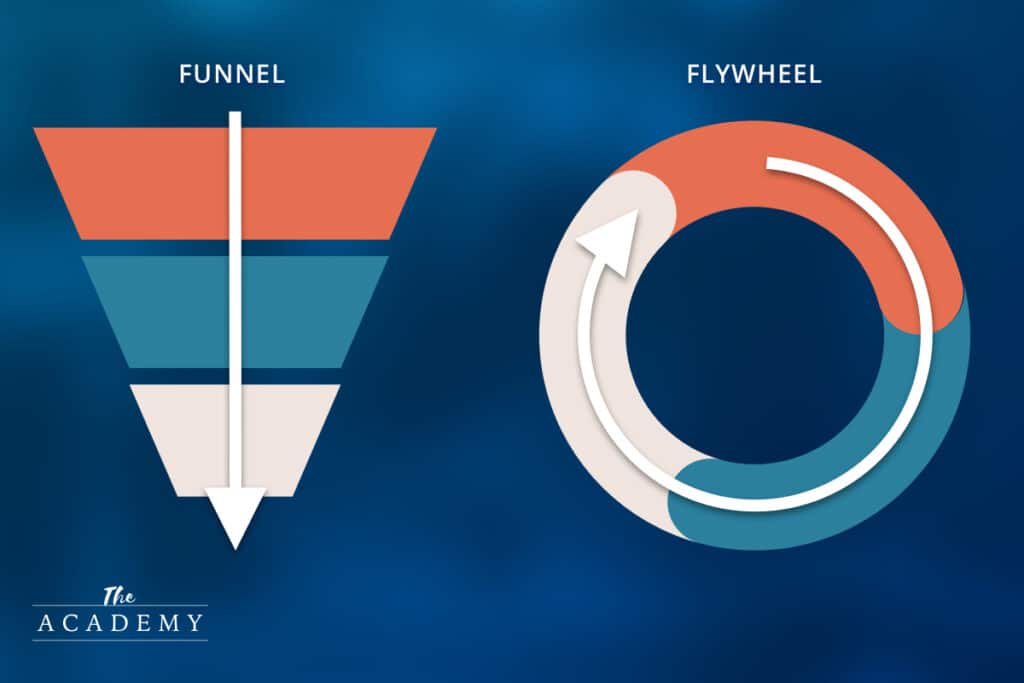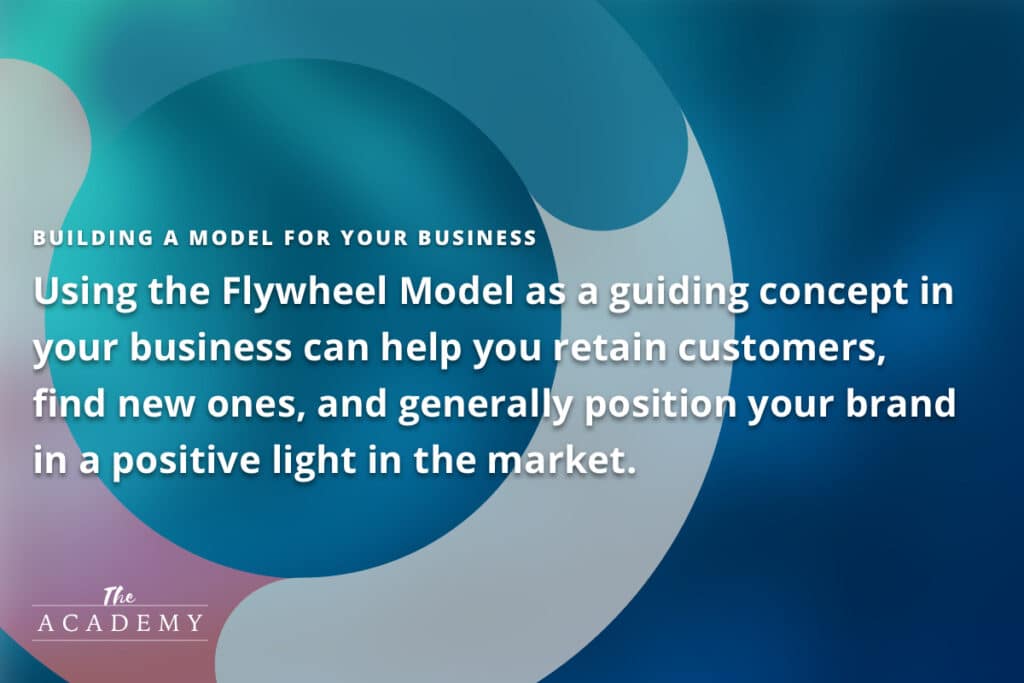
There are many different models used by companies in an effort to achieve growth in both the short- and long-term. One of those models—the Flywheel Model—leans on inbound methodology to build a strong brand that properly serves the market and creates natural momentum to achieve improved results moving forward.
If you are a bit intimidated by the idea of using a business model to think about how your company operates, don’t turn away. This is a simple concept that has the potential to deliver powerful results. We think you’ll find that reading the sections below will be worth your time and your brand will be better for the time and effort you invest. Let’s get started!
Understanding the Concept of the Flywheel
First, we need to lay out the big-picture concept of a flywheel and what it means for how your business operates. Later, we’ll get into some specific ideas for how this marketing model can be put into action to help grow your list of customers.
Anyone experienced in marketing already knows the concept of a funnel. The idea of marketing funnels is to bring people in at the top of the funnel and then move them through various stages until they emerge from the bottom as customers. Funnels are great because they help you visualize the process that new customers take from the moment they become aware of your brand to the moment they make a purchase. Having one or more effective funnels in place for your business is an important part of consistently securing new sales.
But funnels only work in one direction. You add new leads to the top of the funnel, those leads are whittled down along the way, and a group of new customers is left when all is said and done. That’s fine, but what if instead of a funnel, you could create something that kept spinning around and around, building its own momentum and helping to feed your business in a somewhat automated fashion?

That’s the idea behind a flywheel. We aren’t saying that you should throw out the idea of funnels entirely. They remain quite important. But the flywheel model will help you see the bigger picture of what you should be trying to create with your marketing efforts. Instead of something that only moves in one direction, requiring you to actively work to keep the top of the funnel full, a flywheel turns largely on its own, with the people coming out of the bottom helping to turn the process over and send others back towards the top.
Keep Your Flywheel Spinning with the Right Energy Source
To keep a flywheel spinning, it’s necessary to add energy to the system. There is no such thing as a perpetual motion machine. So where does the “energy” come from in the metaphor of a business flywheel? Your goal with this model is to use your customers as the driving force that keeps the wheel moving. This way, the wheel can propel itself in a sense, as you can take a largely passive role while those who have already gone through a funnel and turned into a buyer can encourage others to follow that same journey.
Of course, customers aren’t just going to take this action for nothing. You need to construct everything about the customer experience to be pointed in the direction of earning referrals and positive reviews from as many people who make a purchase as possible. No business succeeds in impressing 100% of its customers (that’s just not realistic), but you can strive to get as close to perfection as possible. The more happy customers that complete a transaction with your business, the more possible referrals to be waiting to keep the flywheel spinning.
How Does a Customer Become a Promoter?
It’s one thing to close a sale and earn revenue from someone who started out at the top of your funnel. That’s great, but it might be just a one-time event—especially if you sell the kinds of things that aren’t purchased frequently. Without the possibility for this customer to be a frequent repeat buyer, you’ll be back where you started looking for new customers.
That is, unless this customer was so happy with what they received that they decided to tell other people about you and your business. That’s the ultimate goal of the flywheel, and it’s the only way to keep the wheel spinning (without inputting significant resources from your organization in the form of time, money, or both). So, what is it about what you can offer your customers that is naturally going to compel them to want to tell others about you? Here are some possibilities:
- Unique offerings. Nearly every market is crowded in the modern business landscape, so it’s always hard to stand out. Most of the time, customers are picking from offerings that are very similar, not only in terms of price, but also in terms of product features and quality. One sure way to earn more than your share of referrals is to stand out by creating something not otherwise seen in your market. This is not easy to do, of course, but it can be highly lucrative if you pull it off. Working hard to offer buyers something that they haven’t seen elsewhere will not only serve to move the flywheel along, but it will also help you convert more people when they enter your funnel for the first time.
- Outstanding service. If you can’t stand out on the basis of what is included in your products or services, make it a point of focus to offer uncommon service to your customers. Check in regularly both before and after the purchase, make your support friendly and easy to access, and generally go above what is expected in your industry. This is a powerful way to compel people to talk about your business to others – if you make their life easier rather than harder, they are almost certain to sing your praises.
- The right price. It might go without saying that offering a lower price than your competitors is another strong way to get people talking. If they can get the same thing from you that they can get elsewhere, but you offer it for less, that will always be popular. This is tricky, however, as letting quality slip in favor of low prices will usually not end well. It’s only worth competing on price if you can still deliver the quality of product or service that buyers in your market have come to expect.
- Being a true partner. It’s easy enough for potential customers to find places to make a purchase. What’s often harder is to find a company that is going to offer real support in the way that one partner would help another. Rather than just trying to close a sale, you should be seen as a company that wants to help the buyer reach their goals, whatever those may be. How this looks will vary dramatically from one industry to the next, and whether you are selling to consumers or to other businesses. Either way, seeing your role in this process as one of providing support and guidance toward a desired outcome will cause the buyer to value their relationship with you, and promoting you to others will follow naturally.
Funnels + Flywheels Working Together
Okay, so we’ve talked about how you can aim to impress your customers in such a way that they will strongly desire to promote your business to others. Now it’s time to zoom out and talk a bit about how this whole marketing picture can come into focus. As we mentioned earlier, you aren’t going to be throwing out the idea of using funnels in your business to drive sales. Rather, you’ll be adding this Flywheel Model to what you already do to create a holistic view of how you can continue to grow revenue.
Think about using a flywheel as an overall definition of how your marketing works and what your goals are when attracting new customers. You want those customers to add energy back to the wheel to keep it turning and keep bringing in new people. Within that wheel, you will have a funnel—or, more likely, a series of funnels—that are used to move leads along and meet customer needs. As time moves along, you can gradually adjust and improve those funnels to make sure they are serving the greater flywheel concept successfully.
Funnels are important because they allow you to focus more specifically on areas of your process that might get lost if you think only about the bigger flywheel. For example, your sales funnel that is going to take people from cold leads to actual customers is a valuable asset for your business. Knowing in great detail how that funnel works, and whether or not it is working well, is vital. You can zoom in on that funnel and improve any portions of it that don’t seem to be performing up to expectations. These kinds of updates should be perpetual, with your funnels gradually improving in quality along the way.
The beauty of using this blended funnel and flywheel approach is that you’ll be working toward reaching many goals simultaneously. For instance, fine-tuning that sales funnel should help you optimize your conversion rate, which is always a good thing. At the same time, a better funnel will mean a better experience for the eventual customer, making them more likely to refer your business to others down the line. So it’s a win-win in the end. You close more deals, and you have more customers who are pleased with your service and want to tell others to visit you, as well.

Using the Flywheel Model as a guiding concept in your business can help you retain customers, find new ones, and generally position your brand in a positive light in the market. We hope the discussion above has helped you bring this idea into focus, and we hope you’ll put some of the ideas into action moving forward.
Most Popular Articles

Seeing Favicons in Your Google Search Results? Here’s Why…
Have you noticed anything different in your Google Search results lately? Google added tiny favicon icons to its organic search results in January. It was…

Business Growth and Digital Marketing News & Tips 11-17-24
Are you encouraging and rewarding innovation? Lee Cockerell is the former Executive Vice President of Operations at Walt Disney World. A lover of traditional red…

Business Growth and Digital Marketing News & Tips 11-27-24
A culture of gratitude "Feeling gratitude and not expressing it is like wrapping a present and not giving it." – William Arthur Ward Beyond being…








